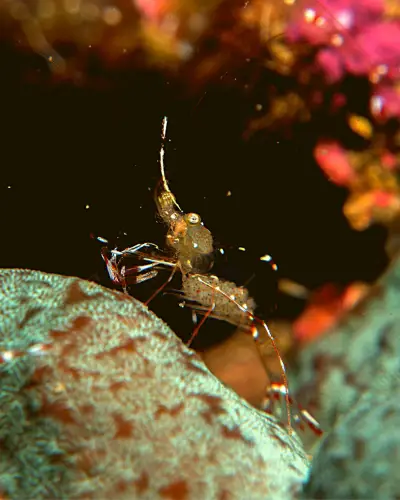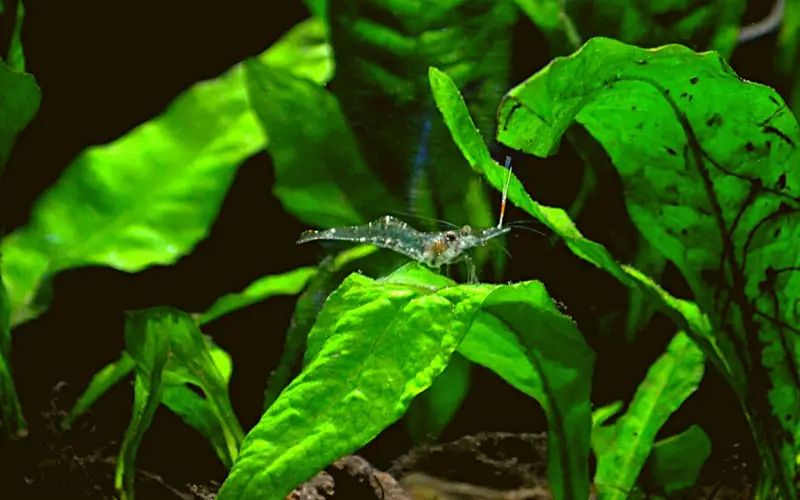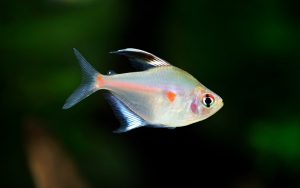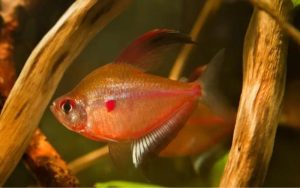What size tank do ghost shrimp need? Ghost shrimp are one of the most common freshwater shrimp species for beginners. They are easy to care for, hardy, and relatively inexpensive. However, one of the most important factors to consider when setting up a ghost shrimp tank is the size of the tank. So what is the ideal ghost shrimp tank size to thrive healthy?
The min tank size for ghost shrimp is 5 gallons. However, for a happy and healthy colony of ghost shrimp, you should aim for a tank size of at least 10 gallons.
This will give your shrimp plenty of space to swim, explore, and hide. In addition to the tank size, there are a few other factors to consider when choosing a tank for ghost shrimp.

The tank should have a sandy substrate, plenty of plants, and a gentle water flow. You should also add a water filter to keep the water clean and debris-free.
With the right ghost shrimp breeding tank size and setup, you can enjoy your glass shrimp for many years. So what are you waiting for? Start planning your perfect ghost shrimp tank today!
Table of Contents
ToggleAre Ghost Shrimp Right for You?
If you’re looking for a small shrimp to add to your tank, grass shrimp may be the right choice. These tiny creatures are known for their small size, perfect for aquarium enthusiasts with limited space.
Ghost shrimp are also relatively easy to care for, making them great options for beginners. They are naturally peaceful and can easily coexist with other fish or invertebrates in the tank.

Additionally, ghost shrimp are scavengers, which will help clean up any uneaten food or debris in your tank, contributing to a cleaner and healthier environment for your aquatic pets.
However, it’s important to note that glass shrimp are known for being sensitive to environmental changes. Therefore, ensuring that your tank water is properly maintained with the right temperature, pH levels, and filtration is crucial for the well-being of these small shrimp.
In short, ghost shrimp may be the perfect fit if you’re looking for a low-maintenance, small-sized shrimp to add to your tank.
What’s The Best Ghost Shrimp Tank Size?
The best size tank for ghost shrimp is 5 gallons or larger. This will give them enough space to roam and hide and make it easier to maintain the water quality. If you have a smaller tank, you can keep ghost shrimp alone, but you must be more careful about overstocking and water quality.
A general rule is to hold at most 3-5 ghost shrimp per gallon of water. This number might vary depending on the size of the shrimp, your filter type, and how often you do water changes.
If you are keeping a group of female ghost shrimp, you may need to increase the tank size to 10 gallons or more, as female shrimp can produce many offspring.
If you plan on using grass shrimp as feeders for other fish, you can keep them in a smaller tank. However, providing them with plenty of hideouts is important so they stay calm.
Here are some tips for setting up a tank for ghost shrimp:
- Use a soft fish tank substrate, such as sand or round gravel.
- Add live plants to the tank. This will help to provide hiding places for the shrimp and improve the water quality.
- Use a filter that is rated for the size of your tank.
- Do water changes once a week.
- Test the water quality regularly.
With proper care, glass shrimp can live for up to 2 years. They are so easy to care for and add to small home aquariums.
Should You Bring Ghost Shrimp for Your Small Aquarium?
If you’re considering adding a new inhabitant to your Aquarium, a ghost shrimp could be a great choice. These tiny shrimp are often considered a beneficial addition to a tank due to their small size and interesting behavior.
Transparent shrimp are usually transparent in color, which gives them their name. They are relatively easy to care for and adapt well to different water conditions. Their small size makes them compatible with various tank mates, such as small fish or other peaceful shrimp species.
However, it’s important to note that ghost shrimp can sometimes display aggressive behavior towards each other, especially if the tank is too small or doesn’t have enough hiding places. If you have a well-established and properly maintained aquarium, getting a ghost shrimp could be a captivating addition to your tank.
How Many Ghost Shrimp can be Kept in the Aquarium?
The number of ghost shrimp that can be kept in an aquarium depends on the size of the tank and the amount of space available. Generally, it is recommended to have at least 1 gallon of water per ghost shrimp.
Therefore, a 10-gallon tank can house around 10 glass shrimp comfortably. However, it is important to consider other factors, such as filtration, water quality, and the presence of other tank inhabitants.
Ghost shrimp are social creatures and thrive in small groups. Keeping too many ghost shrimp in a small tank can cause overcrowding and stress for these small crustaceans. It is always recommended to start with a few ghost shrimp and monitor their behavior and the tank conditions before adding more.
The well-being of the shrimp should be the primary concern, and providing them with a suitable environment is essential for their health and happiness.
What Factors Can Impact The Number Of Ghost Shrimp You Can Keep?
Several factors influence the number of ghost shrimp you can keep.
Firstly, it depends on the size of your tank or Aquarium. A larger tank will allow for more shrimp to be kept, whereas a smaller tank will limit the number of shrimp you can have.
Secondly, ghost shrimp behavior also plays a role. If the shrimp are territorial or aggressive, it may be necessary to have fewer shrimp to avoid conflicts.
Ultimately, the number of shrimp you can keep will be determined by the tank size, gallon capacity, and the behavior of the ghost shrimp themselves.
There are a few factors that can influence the number of ghost shrimp you can keep in a tank:
- Tank size: The larger the shrimp tank, the more shrimp you can keep. A good rule of thumb is to keep 5 ghost shrimp per gallon of water. However, you can keep more shrimp if you have a very large tank. Just provide plenty of hiding places and food for your shrimp.
- Ghost shrimp behavior: Ghost shrimp are relatively peaceful creatures but can be territorial around food. If you have a lot of shrimp in a small tank, they may fight over food. Keeping at most 10 shrimp per gallon of water is best to prevent this.
- Water quality: Ghost shrimp are sensitive to water quality, so keeping the water clean and well-maintained is important. If the water quality is poor, your shrimp may become stressed and sick. To keep the water quality in good condition, you’ll need to do regular water changes and test the water parameters regularly.
- Tank mates: Grass shrimp could be kept with other peaceful fish or shrimp. However, avoiding them with aggressive fish or fish that eat ghost shrimp is important. Some good tank mates for ghost shrimp include guppies, mollies, neon tetras, and snails.
Overall, the number of ghost shrimp you could keep in a tank will depend on the tank’s size, the shrimp’s behavior, the water quality, and the tank mates. By following these guidelines, you can ensure that your shrimp have a healthy and happy home.
Here are some additional tips for keeping ghost shrimp:
- Provide plenty of hiding places for your shrimp. Ghost shrimp like to hide in plants, rocks, and other decorations.
- Feed your shrimp a varied diet of algae, pellets, and frozen foods.
- Keep the water tank temperature between 72 and 80 degrees Fahrenheit.
- Test the water parameters regularly and do regular water changes.
- Avoid keeping glass shrimp with aggressive fish or fish that eat shrimp.
With proper care, ghost shrimp can make great additions to your Aquarium. They are simple to care for and can add a touch of beauty to your home Aquarium.
How to Control Ghost Shrimp Population in the Tank?
To control the population of ghost shrimp in the tank, it is important to understand their breeding habits. Ghost shrimps reproduce quickly, and pregnant ghost shrimps can release hundreds of eggs at a time, leading to a surge in population.
One effective method is to transfer pregnant ghost shrimps to a separate tank or Aquarium to prevent them from reproducing in the main tank. This allows you to control the population growth and keep it manageable.
Additionally, introducing other species, such as red cherry shrimp, can help control the grass shrimp population, as they may prey on ghost shrimp eggs. It is also important to monitor the size and capacity of the tank.
Ghost shrimps thrive in smaller tanks, so upgrading to a larger tank, such as a 10 gallon tank, may deter their growth. By implementing these strategies, you can successfully control the ghost shrimp population in your tank and maintain a harmonious aquatic environment.
Best Ghost Shrimp Tank Mates
When selecting tank mates for ghost shrimp, it’s important to consider species compatibility, water parameters, and the size of your tank. Ghost shrimp are generally peaceful and can coexist with various community tank mates. Here are some popular choices for ghost shrimp tank mates:
- Small Fish: Choose small, non-aggressive fish that won’t prey on or harass the shrimp. Good options include neon tetras, guppies, endlers, rasboras, and dwarf or pygmy corydoras catfish. Ensure that the fish need to be bigger to eat the ghost shrimp.
- Snails: Many snails can peacefully coexist with ghost shrimp and help maintain the tank’s cleanliness. Nerite snails and Malaysian trumpet snails are popular choices. Avoid larger snails like apple snails that may accidentally harm the shrimp.
- Dwarf Shrimp: Ghost shrimp can be kept with other dwarf shrimp species, such as cherry shrimp, amano shrimp, or crystal red shrimp. Ensure the shrimp tank has plenty of hiding places and vegetation to accommodate multiple shrimp species.
- Otocinclus Catfish: Otocinclus catfish, also known as otos or dwarf suckermouth catfish, are peaceful algae eaters compatible with grass shrimp. They help keep the tank clean by consuming algae, and their small size makes them suitable for smaller tanks.
- Corydoras Catfish: Some species of Corydoras catfish, such as the pygmy corydoras or panda corydoras, make good tank mates for ghost shrimp. They are peaceful, bottom-dwelling fish that won’t pose a threat to the shrimp.
Monitor your tank closely after introducing new tank mates to ensure peaceful coexistence. Provide plenty of hiding spots, plants, and adequate food for all inhabitants. Maintaining stable water parameters, including temperature, pH, and ammonia levels, is crucial for the well-being of ghost shrimp and their tank mates.
Ghost Shrimp Care Schedule
Here is a sample shrimp ghost care schedule that you can follow:
Daily:
- Check on your shrimp for any signs of stress or illness.
- Feed your pet shrimp once or twice a day, depending on their size and activity level. Provide a balanced diet of pellets, flakes, and occasional live foods like baby brine shrimp, daphnia, or bloodworms.
- Test the water parameters to make sure they are within the recommended range.
Weekly:
- Perform a 25% water change.
- Clean the filter media.
- Trim any dead shrimp or dying plants.
Monthly:
- Perform a 50% water change.
- Clean the tank thoroughly, including the substrate, decorations, and glass.
- Replace the filter cartridges.
Additionally, you should:
- Quarantine new pet shrimp for at least two weeks before adding them to your main fish tank.
- Avoid using copper-based medications in your tank, which can harm ghost shrimp.
- Keep the water temperature between 72 and 80 degrees Fahrenheit.
- Maintain a pH level of 7.0 to 8.0.
- Use soft, dechlorinated water.
- Provide plenty of hiding places for your shrimp.
- Plant your tank with live plants.
Following this care schedule can help ensure that your glass shrimp live a long and healthy life.
Here are some additional tips for keeping your ghost shrimp happy and healthy:
- Provide a varied diet. Ghost shrimp will eat various foods, including algae, biofilm, plant matter, and small invertebrates. You can also feed them pellets, flakes, and live or freeze-dried foods like daphnia, brine shrimp, and bloodworms.
- Keep the water clean. Ghost shrimp are susceptible to water quality problems, so keeping the water in their tank clean and well-maintained is important. Perform regular water tank changes and test the water parameters regularly.
- Provide a safe environment. Ghost shrimp are prey animals, so they need a tank with plenty of hiding places. You can use plants, rocks, and driftwood to create hiding places for your shrimp.
- Avoid using copper-based medications. Copper is toxic to ghost shrimp, so avoid using copper-based medications in your tank.
- Quarantine new shrimp. Before adding new shrimp to your tank, it is important to quarantine them for at least two weeks. This will help stop the introduction of diseases or parasites into your tank.
Following these tips can help ensure that your pet shrimp live a long and healthy life.
Ghost Shrimp Behavior and Temperament
Ghost shrimp are peaceful and social creatures that greatly add to community tanks. They are relatively simple to care for and thrive in various water conditions.
Glass shrimp are typically found at the bottom of the tank, rummaging for food and hiding from predators. They are active swimmers who occasionally dart around the tank but always return to the bottom.
Ghost shrimp are not aggressive and will not bother other tank mates. However, they can be preyed upon by larger fish, so it is crucial to choose tank mates that are compatible in size.
Ghost shrimp molt their shells regularly. During this time, they are vulnerable and should be protected from predators. Providing plenty of hiding places for adult ghost shrimp when they are molting is important.
Here are some tips for keeping ghost shrimp happy and healthy in your Aquarium:
- Provide a cycled tank with soft, slightly acidic water.
- Add live plants and decorations to provide hiding places.
- Feed various foods, including algae wafers, shrimp pellets, and vegetables.
- Monitor the water quality regularly and make sure the temperature is between 70 and 79 degrees Fahrenheit.
- Avoid adding large or aggressive fish to the tank.
With the right care and attention, your pet shrimp might live for up to two or three years. They are a great addition to any aquarium and make fascinating creatures to watch.
Here are some additional details about grass shrimp behavior:
- Ghost shrimp are nocturnal, so they are most active at night.
- They are scavengers and will eat algae, residue, and small insects.
- They are social creatures and will often huddle together in groups.
- They are relatively easy to breed, and their young are very hardy.
Ghost shrimp are a great choice if you want a peaceful and easy-to-care-for aquarium creature. They are a fascinating addition to any tank and can provide hours of enjoyment.
How Often Do Ghost Shrimp Molt?
Ghost shrimp molt at different frequencies depending on their age and health.
- Larval stage: Ghost shrimp molt almost daily during the larval stage.
- Post-larvae stage: Ghost shrimp molt every 3-4 days during the post-larvae stage and grow by up to 20 percent.
- Juvenile stage: Ghost shrimp molt every 4-10 days during the juvenile stage and grow by up to 7 percent.
- Adult stage: Adult ghost shrimp molt once a month or every 3-4 weeks.
The frequency of molting can also be affected by the following factors:
- Water quality: Ghost shrimp need clean, well-oxygenated water to melt properly. The molting process can get delayed or even prevented if completed on time.
- Nutrition: Ghost shrimp need a protein and calcium diet to support molting. If they are not getting enough nutrients, they may molt less frequently or have problems with their molt.
- Stress: Glass shrimp can be stressed by environmental changes, such as a new tank, new tankmates, or aggressive fish. Stress can also delay or prevent molting.
If you notice that your shrimp is not molting as often as it should, it is important to check the tank’s water quality, diet, and stress levels. The molting process should return to normal if you can identify and address the problem.
Ghost Shrimp Tank Setup: What You’ll Need
Setting up a ghost shrimp tank requires a few essential items. First, you need an aquarium or tank to house your ghost shrimp. A 10-gallon tank is a good size, depending on the number of shrimp you plan to have.
Ghost shrimp tanks should include a live plant, as these shrimp need vegetation to hide in and feel secure. Additionally, ghost shrimp need a filter to keep the water clean and a heater for a temperature between 72-82°F.
Depending on the size of your tank, you may also need a substrate, such as sand or soft gravel, for the bottom of the tank. Ghost shrimp can coexist with other peaceful fish species if the tank setup allows it.
Here is what you’ll need to set up a ghost shrimp breeding tank:
- Aquarium: the ghost shrimp min tank size is a 5-10 gallon aquarium. You’ll need a larger tank if you plan on keeping more than a few shrimp.
- Filter: A good sponge filter is essential for keeping your ghost shrimp’s water clean. A sponge filter or HOB filter will work well.
- Heater: Ghost shrimp prefer water temperatures between 65 and 82 degrees Fahrenheit. A heater will help you keep a consistent water temperature.
- Substrate: Ghost shrimp can be simple in terms of the substrate. A simple sand or gravel substrate will do.
- Live plants: Live plants are a must-have for ghost shrimp tanks. They provide food and hiding places for the shrimp and help improve the water quality.
- Decorations: Ghost shrimp can also appreciate some decorations in their breeding tank. You can add rocks, driftwood, or even fake plants. Just make sure there are enough hiding places for the shrimp.
Here are some additional things to keep in mind when setting up a ghost shrimp tank:
- Water quality: Ghost shrimp are small and sensitive to water quality, so it’s important to test the water regularly and ensure the parameters are within their ideal range.
- Tank mates: Ghost shrimp are peaceful creatures and can be kept with other fish species. However, it’s important to choose tank mates that are small enough not to eat the shrimp.
- Feeding: Ghost shrimp are omnivores and will eat a variety of foods. You can feed them flakes, pellets, or live food like brine shrimp or bloodworms.
With proper care, ghost shrimp can make great additions to any aquarium. They’re relatively easy to take care of and can provide hours of entertainment.
Ghost Shrimp Lifespan & Molting
The ghost shrimp’s lifespan is relatively short, lasting only about one to two years in a home aquarium. However, they undergo a fascinating process called ghost shrimp molt during this time.
Molt refers to the shedding of its exoskeleton as the shrimp grows. This process typically occurs at the bottom of the tank, where the shrimp find a secure spot to molt. The outer shell splits open, and the shrimp wiggles out of its old skin, leaving behind a fragile and transparent version of itself.
After molting, the shrimp gradually hardens its new exoskeleton, which takes a few days. Ghost shrimp often use this molting process, adding intrigue and wonder to any aquarium.
Commonly Asked Questions about Feeder Glass Shrimp Size Tank (FAQs)
What is the recommended tank size for ghost shrimp?
The recommended ghost shrimp fish tank size is at least 5 gallons.
What is ghost shrimp molt?
Ghost shrimp molt is when a shrimp sheds its old exoskeleton to grow a new and larger one.
Can ghost shrimp live with other fish?
Yes, ghost shrimp can live with other fish as long as the fish are not aggressive and large enough to eat the shrimp.
How do you breed ghost shrimp?
To breed ghost shrimp, you need to have both male and female shrimp in a well-maintained tank with plenty of hiding spaces and plants for the female to attach her eggs.
How big do ghost shrimp grow?
Ghost shrimp typically grow to a size of about 1-2 inches.
Can ghost shrimp be used as feeder fish?
Yes, ghost shrimp can be used as feeder fish for larger predatory fish.
What type of tank should I use for ghost shrimp?
A freshwater aquarium with a filtration system and a heater to maintain the perfect water temperature suits ghost shrimp.
What should I feed my ghost shrimp?
Ghost shrimp can be fed a variety of food sources, including fish pellets, shrimp pellets, and blanched vegetables.
What happens when a ghost shrimp is berried?
When a ghost shrimp is berried, it means that it is carrying eggs under its abdomen. It is important to provide a breeding tank until the eggs hatch.
Do ghost shrimp eat other shrimp?
Ghost shrimp will often eat baby shrimp of their kind, so it is best to separate them if you want to keep both types of shrimp in the same tank.
Conclusion
So, what is the perfect feeder ghost shrimp tank size? Ghost shrimp are a great choice for beginner aquarium fans because they are easy to care for and require a small tank size. A five-gallon aquarium is the minimum size for a group of ghost shrimp, but a 10-gallon tank is ideal. When choosing a tank, ensure it has a lid to prevent the shrimp from escaping. You must also add a filter, heater, and live plants to the tank. Ghost shrimp are omnivores, so you can feed them various foods, such as algae wafers, shrimp pellets, and bloodworms.
With proper care, ghost shrimp can live for up to 2 years. If you are looking for a low-maintenance and interesting aquarium pet, ghost shrimp are a great option. They are relatively economical to purchase and care for and add a touch of beauty and diversity to your tank. So what are you waiting for, breeding ghost shrimp? Get started with your ghost shrimp tank today!
You might also like
- How Many Ghost Shrimp in a 5 Gallon Tank: A Detailed Answer
- Saltwater Ghost Shrimp: 7 Shocking Facts You Won’t Believe!
- Keeping Shrimp as Pets: 5 Proven Hacks for Stunning Aquarium
- Ghost Shrimp Eggs Hatching: 5 Foolproof Secrets for Success!
- Easiest Shrimp to Keep: 5 Effortless Delights You’ll Adore!
- How Many Ghost Shrimp in a 10 Gallon Tank: A Detailed Guide
- Why Are Ghost Shrimp So Cheap: (5 Astonishing Reasons)
- Do Shrimp Shed Their Skin? 3 Surprising Facts About Molting!
- Do All Shrimp Eggs Hatch at Once? The Answer Will SHOCK You!
- Freshwater Shrimp Breeding 101: (A Comprehensive Guide)
- Breeding Cherry Shrimp: 5 Hacks for Rapid Success!
- How Many Freshwater Shrimp Per Gallon: (A Comprehensive Guide)
- Do Red Cherry Shrimp Need a Heater: Truth Will Save Your Shrimp!





